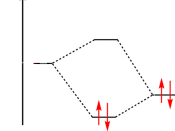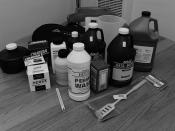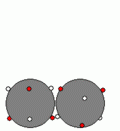Ionic Bond
* bond formed between oppositely charged ions because of electrostatic forces of attraction.
example: sodium + chlorine ----> sodium chloride
Ionic compound
* a compound composed of ions.
* Metal atoms lose electrons to form positive ions, called cations, which are smaller than the original atom.
The loss of an energy level with electrons, plus the excess positive charge draws the remaining electrons toward the nucleus and causes the electron cloud to contract even more.
* Nonmetal atoms gain electrons to form negative ions, called anions, which are larger than the original atom.
The addition of an extra electron increases the electron-electron repulsion and causes the electron cloud to expand.
* The main Group elements (s and p orbitals) lose or gain electrons to attain a configuration like a noble gas.
* Transition elements (d orbitals) lose their s orbital electrons first and then one or more d orbital electron(s).
Covalent bonds: formed from sharing of two electrons, usually one donated from each of the two bonding atoms. Sharing electrons is one way that atoms can satisfy the "Octet Rule" which as stated by Gilbert Lewis "atoms, by sharing electrons to form an electron-pair bond, can acquire a stable, noble-gas structure".
There are 3 kinds of covalent bonds based on number of pairs of electrons shared between the two atoms:
single covalent bond - 1 shared pair
double covalent bond - 2 shared pairs
triple covalent bond - 3 shared pairs
Bond energy: single < double < triple
Bond length: single < double < triple
Lewis Structures: The simplest covalent bond is between two hydrogen atoms. Electron-dot (or Lewis) symbol for hydrogen is H.. The two electrons from two hydrogen atoms pair up to make H:H. The pair of dots can be replaced by a dash to represent...


